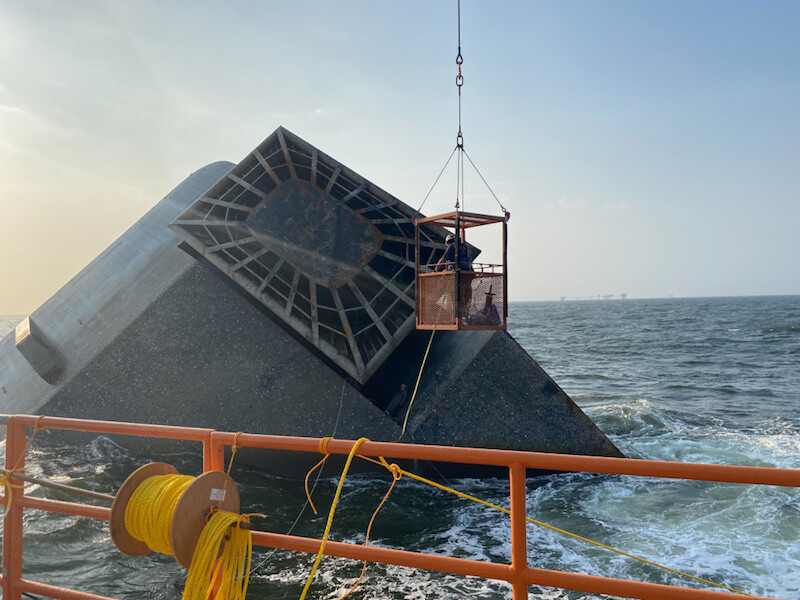Throughout the last week, contracted salvage crews have been removing obstructions from the seafloor around the partially sunken 175' liftboat Seacor Power. Removal of the debris will make room for the equipment needed to raise vessel sections to the surface.
The 265-class Seacor Power is a three-legged liftboat with a 49'x29'x5' working pad. It has a cargo deck capacity of 491 LT and a clear area of 11,000 sq. ft. It is outfitted with two cranes, port and starboard, each 185-ton capacity with 120' boom.
The Seacor Marine liftboat capsized in heavy weather about eight miles off the Louisiana coast. Of the 19 people onboard the Seacor Power that left Port Fourchon on Tuesday afternoon April 13, six are now dead, six have been rescued, and seven are still missing.
The Seacor Power remains in the same location where it sank but has rotated, and salvors report cracking and separation of the hull from the superstructure. The separation indicates that the structural integrity of the vessel is compromised. As a result, the vessel will have to be raised to the surface and brought to shore in separate sections.
The Donjon-SMIT salvage team is outfitting a barge with a pump system that allows it to be submerged and maneuvered under the larger sections of the vessel. Once in place, water is pumped out of the barge and it is refloated with the larger sections already on board in conjunction with assistance from a crane barge on the surface. This method preserves the structural integrity of the recovered section.
Safety netting will be placed around the openings of each section as it is raised and transported.
Removal of the largest sections is expected to be complete by the end of June, but the timeline depends on many factors including the safety of salvage crews, the weather, and any new structural changes that may occur. Seacor assets will remain in the area until the end of July to recover any remaining debris from the sea floor.
The Coast Guard safety zone extending one nautical mile around the site and the Federal Aviation Administration temporary flight restriction covering a five nautical mile radius around the site and 2,000-foot minimum altitude will remain in place until salvage operations are complete. These restrictions are in place to ensure the safety of divers and salvage crews working at the site as well as boaters who could place themselves in danger by transiting through an active work site where debris and other underwater obstructions such as anchor wires, mooring ropes, and navigational buoys may be present.
The Coast Guard continues to monitor for any oil discharges, and Seacor Marine has an Oil Spill Response Organization standing by to respond to any situation in which there is recoverable oil, although the Coast Guard reported earlier that diesel fuel and other liquids have already been removed.
The incident is under investigation by the National Transportation Safety Board (NTSB) and the Coast Guard.
The unified command consisting of the Coast Guard and Seacor updated family members of the crew on the status of salvage operations of Seacor Power during a meeting in Houma, Wednesday.
Family members were provided with information from Seacor and the contracted Donjon-SMIT salvage team on efforts to remove the vessel and what the potential timeline for that process is expected to be.
In a preliminary report released in May, the NTSB said that turning the liftboat into the wind during a squall while the vessel’s legs were lowering couldn’t keep the boat from capsizing.
“Information in the report is preliminary and subject to change as the investigation progresses and as such, no conclusions about the cause of the accident should be drawn from the report,” an NTSB statement warned.
The Seacor Power left Port Fourchon at about 1:30 p.m. April 13, bound for the oil and gas lease area Main Pass Block 138 in the Gulf of Mexico. A weather report emailed to the vessel at 7:02 a.m. that day predicted afternoon winds at 9 to 12 knots from the southeast with 3' seas.
NTSB investigators learned that at about 3:30 p.m., as Seacor Power transited the open waters of the Gulf, a squall passed over the liftboat. With visibility dropping and winds increasing significantly, the crew decided to lower the liftboat’s legs to the seafloor to hold the vessel in position until the storm passed. The crewmember at the helm attempted to turn the Seacor Power into the wind as the legs began to descend. Before the turn was completed, the liftboat heeled to starboard and capsized.
NTSB investigators also learned several people were able to escape onto the exposed, port side of the deckhouse. High winds and seas that had built to 10' to 12' prevented rescuers from reaching those who remained on the liftboat. Some were washed into the water and six were eventually rescued, with one survivor suffering a serious injury.
NTSB investigators have interviewed survivors, other personnel who previously crewed the Seacor Power, representatives for the owner and charterer, vessel inspectors and surveyors, and search and rescue responders.
When the liftboat is salvaged NTSB investigators intend to return to inspect the vessel and collect further evidence.




